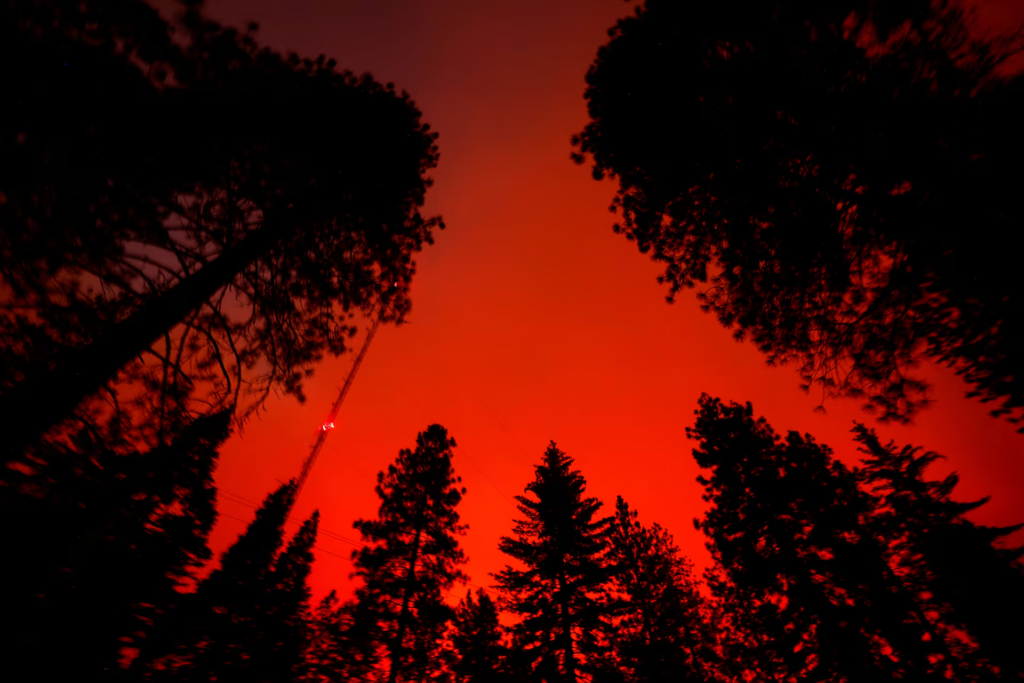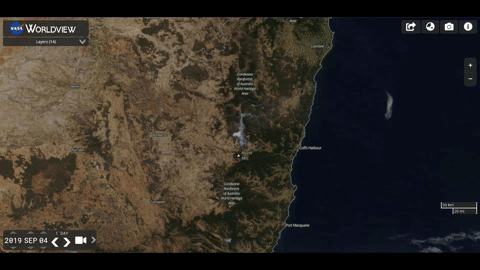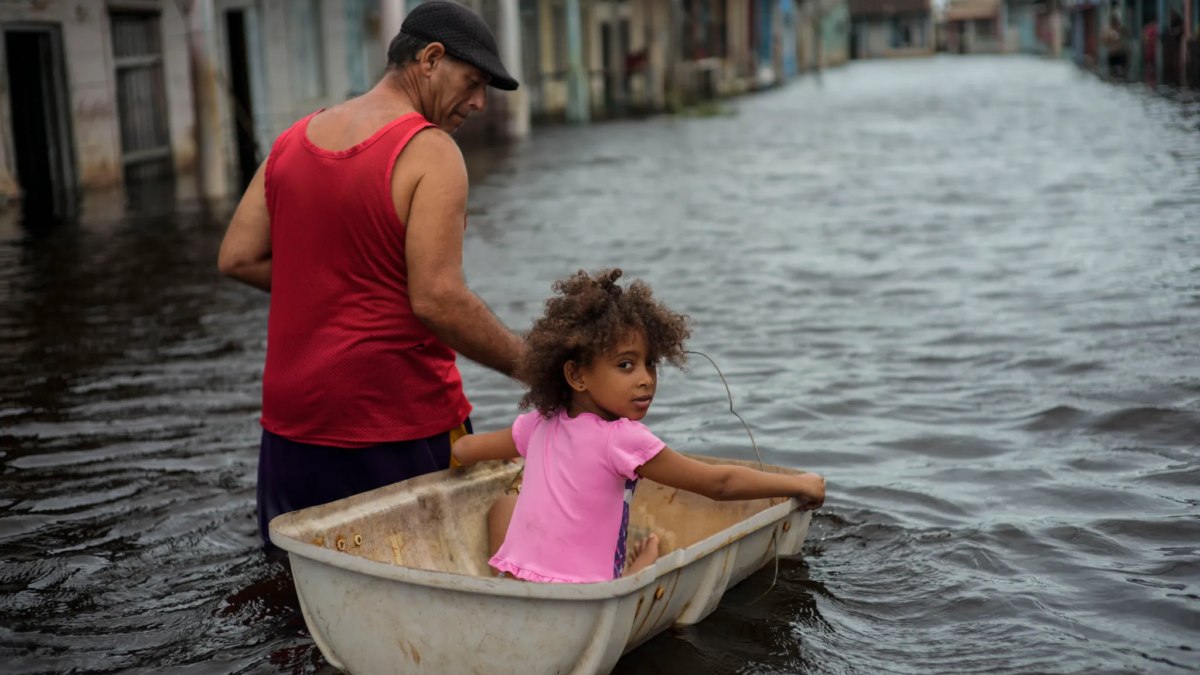A “catastrophic” start to wildfire season in Oregon sparks alarm – Oregon wildfire explodes to half the size of Rhode Island – “This is perhaps the worst I’ve seen in terms of the number of fires on the landscape in the last decade in the state of Oregon”

By Jules Feeney
27 July 2024
LOS ANGELES (The Guardian) – Oregon’s wildfire season is off to an explosive start with more than 1 million acres charred in less than a month, as experts warn that extreme heat and unusual lightning strikes are creating “catastrophic conditions” for fires to ignite and spread.
The state is currently home to the largest wildfire burning in the US. By Friday afternoon, the Durkee fire had burned nearly 290,000 acres (117,000 hectares) and was only 20% contained. The fire had forced evacuations, shut down a major interstate highway and even produced its own weather system.
The Durkee fire is one of more than 100 lightning-ignited fires, including four “megafires”, that have started over the past week and are currently raging in the eastern and central parts of Oregon. A megafire is defined by National Interagency Fire Center as blazes that have burned more than 100,000 acres (40,000 hectares).

The more than 1 million acres (405,000 hectares) charred so far have already quadrupled last year’s total and are approaching the massive 2020 season, which saw 1.2 million acres burned. The fire season typically runs until autumn rains arrive in mid-September, but bad years can see blazes burn into October.
“Our wildfire season is off to a very aggressive start,” said the governor of Oregon, Tina Kotek, at a virtual press conference last Friday. Kotek has declared a state of emergency and officials have issued evacuation advisories impacting some 18,000 people. The wildfires have sent clouds of harmful smoke billowing across Oregon and into neighboring states like Idaho, pushing air quality levels to unhealthy levels.
Experts say the unusually active start to Oregon’s wildfire season is due in part to “flash drought” conditions brought on by unprecedented heatwaves that ripped the moisture from the landscape before it was set ablaze by more than a thousand lightning strikes across the state last week.
The spate of wildfires come amid a persistent heatwave in the Pacific north-west. This month is on pace to be the hottest July in Portland’s recorded history, including three consecutive days of 100F (38C) or higher. Bend, Oregon, just east of the Cascades, saw 19 consecutive days with highs over 95F.

Though drought-like conditions have persisted for decades, many in the state were crossing their fingers that early-summer rains would keep vegetation green, holding off the start of the fire season.
But the rain that did fall over the region quickly evaporated, said Rachel Cleetus, the policy director for the Climate and Energy Program at the Union of Concerned Scientists. But the deadly, record-breaking heat waves that have impacted large swaths of the United States this summer stalled over the Pacific Northwest, causing “flash drought” conditions, she said.
“Even though there was rain earlier in the season, it just wasn’t enough to compensate for the fact that the moisture was completely ripped out of the soils and the vegetation through these extreme heat conditions,” Cleetus said. “That sets up a catastrophic condition should a fire break out.”
More than half of the state is in “Moderate Drought” conditions according to the National Oceanic and Atmospheric Administration’s Drought Status Update. Nearly 40% is “abnormally dry”.
The dried-out landscape was particularly vulnerable last week when dry storms produced more than a thousand lightning strikes that ignited 100 new fires, Kotek said at the press conference.

Colby Neuman, a meteorologist at the Portland National Weather Service, said that lightning is familiar to much of Oregon. But it’s not common, he said, for the “whole state from the coast to the Idaho border” to get “pretty well plastered” by lightning strikes.
The sheer number of fires burning across the landscape, Neuman said, has spread the state’s firefighting resources thin. Firefighters from 10 states have come to Oregon to assist with suppression efforts.
“This is perhaps the worst I’ve seen in terms of the number of fires on the landscape in the last decade in the state of Oregon,” Neuman said.
Oregon has been no stranger to brutal wildfires in the past, but recent years have proved especially challenging. In 2020, five megafires flared up over the Labor Day weekend and scorched over 800,000 acres (324,000 hectares). In 2012, the Long Draw fire burned well over half a million acres in the state, more than any wildfire in over a century.

Oregon is just one of several western regions battling large blazes. In California, the Park fire grew into the largest in that state this year, destroying more than 130 homes and threatening thousands more. In Canada, firefighters are battling 900 blazes, including a ferocious fire that destroyed the picturesque mountain town of Jasper in Alberta.
Scientists have linked heightened wildfire risks to warming global temperatures and greenhouse gas emissions.
In the short term, Neuman said, weather forecasts for Oregon are expected to cool slightly and some areas could see precipitation which would give firefighters an edge. But as the summer continues, the meteorologist said, temperatures could rise again.
“That’s what’s keeping us on edge,” Neuman said.
A ‘catastrophic’ start to wildfire season in Oregon sparks alarm

Oregon wildfire explodes to half the size of Rhode Island
By Rich Mckay
26 July 2024
(Reuters) – Winds and lightning strikes have sparked and fanned wildfires across the Pacific Northwest this week, including the largest fire currently burning in the U.S., which was rapidly expanding near the Oregon-Idaho border on Friday.
The Durkee Fire near Huntington, Oregon, has scorched 600 square miles (1,600 square km), an area more than half the size of Rhode Island’s land mass, authorities said. It is threatening several towns.
The blaze was set off by lightning on July 17, and wind gusts up to 60 mph (100 kph) drove the flames across brush, timberland and ranches, killing hundreds of cattle. The fire was only 20% contained on Friday, officials said.
While there is zero chance of rain through next week, winds have dropped and cooler air is in store, said meteorologist Marc Chenard of the National Weather Service.
“Hopefully it gives firefighters a break,” he said.

As of Thursday, wildfires this year have burned almost 1 million acres (400,000 hectares) in Oregon and 125,900 acres in Washington, according to the Northwest Interagency Coordination Center in Portland, Oregon.
In 2020, the worst year in recent memory, Oregon wildfires scorched more than 1.14 million acres, according to a tally by CBS TV affiliate KOIN.
In California, the Park Fire, believed to have been started by an arsonist, has forced the evacuation of more than 4,000 residents in Butte County, about 100 miles northeast of Sacramento.
A suspect was arrested on Thursday, accused of pushing a burning car down a bone-dry gully.
The fire grew uncontrolled overnight from 125,000 acres on Thursday to 178,090 acres on Friday afternoon, according to the California Department of Forestry and Fire Protection. More than a hundred buildings had been damaged or destroyed.

“The biggest challenge with this fire is getting to it,” said Fire Captain Dan Collins. “It’s steep land with almost no roads. It’s hard to get our people and equipment to the fire lines.”
More than 1,600 firefighters were deployed to contain the blaze, CalFire said.
Forecasters warned that winds would reach 30 miles mph (50 kph) on Friday and through the weekend. Combined with low humidity, it is a recipe for rapid growth, officials said.
Smoke from fires in western Canada and the Pacific Northwest have brought hazy skies and unhealthy air from the Rocky Mountains to Minneapolis and as far east as Detroit, weather reports said.
Denver had the worst air quality in the U.S. on Friday and ranked the 30th worst in the world, according to IQAir, a group that tracks air pollution across the globe.

Much of the smoke coming into the Central and Eastern U.S. comes from a raging wildfire in the mountainous Jasper National Park in the Canadian province of Alberta.
The park and the town of Jasper, which draws more than 2 million tourists a year, were evacuated on Monday, displacing 10,000 residents and 15,000 park visitors. As much as half of the structures in the town could be damaged or destroyed, officials said, as the blaze burned more than 89,000 acres as of late Thursday.
Videos posted on social media show entire streets leveled by the blazes in the Alberta province, with scorched trees, charred metal skeletons of cars, and nothing but rubble where homes and businesses had stood.
Oregon wildfire explodes to half the size of Rhode Island


